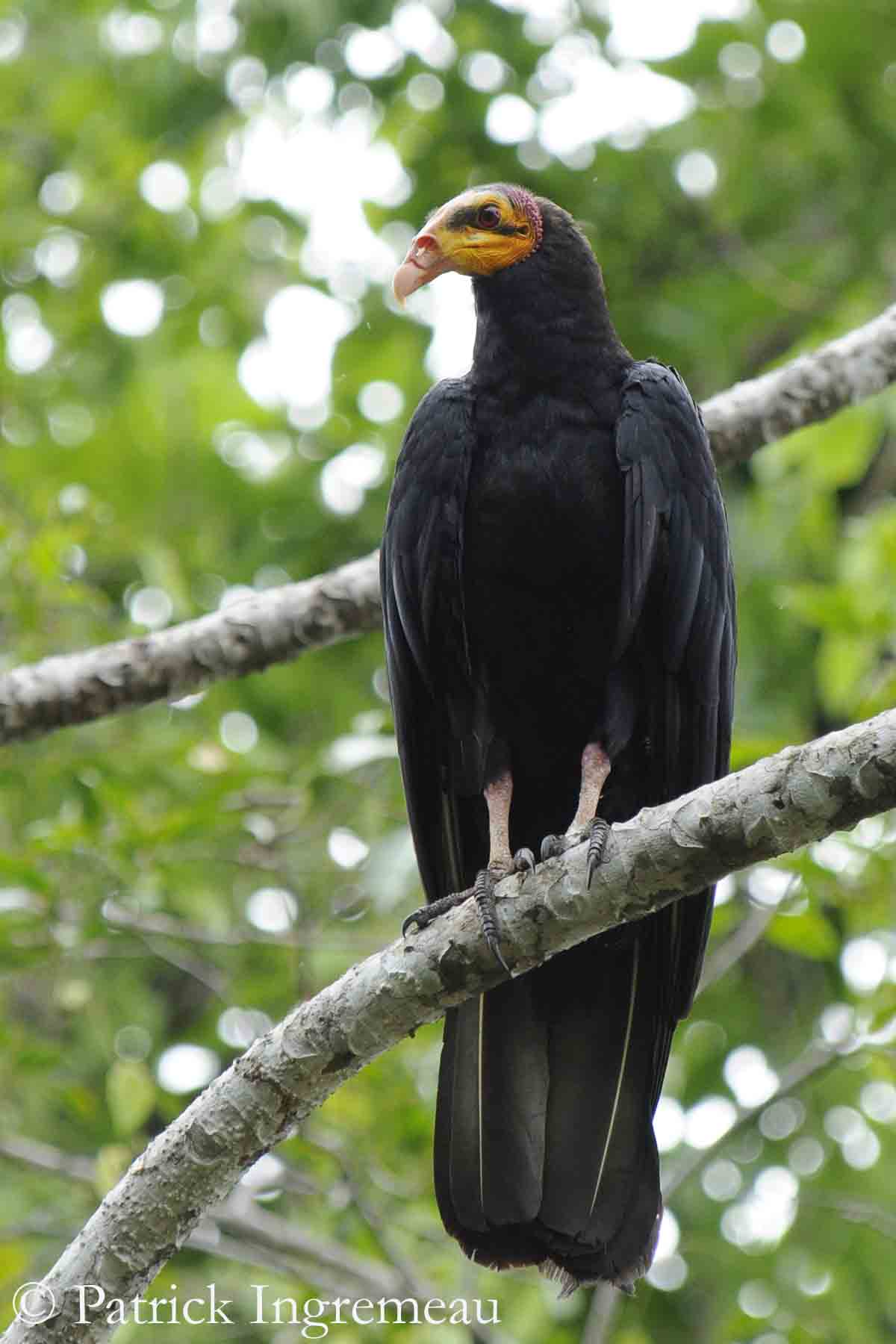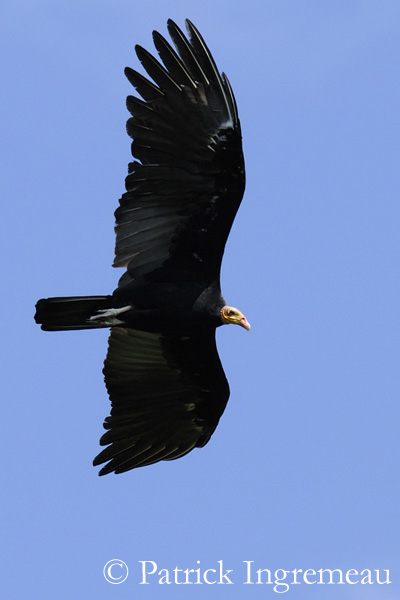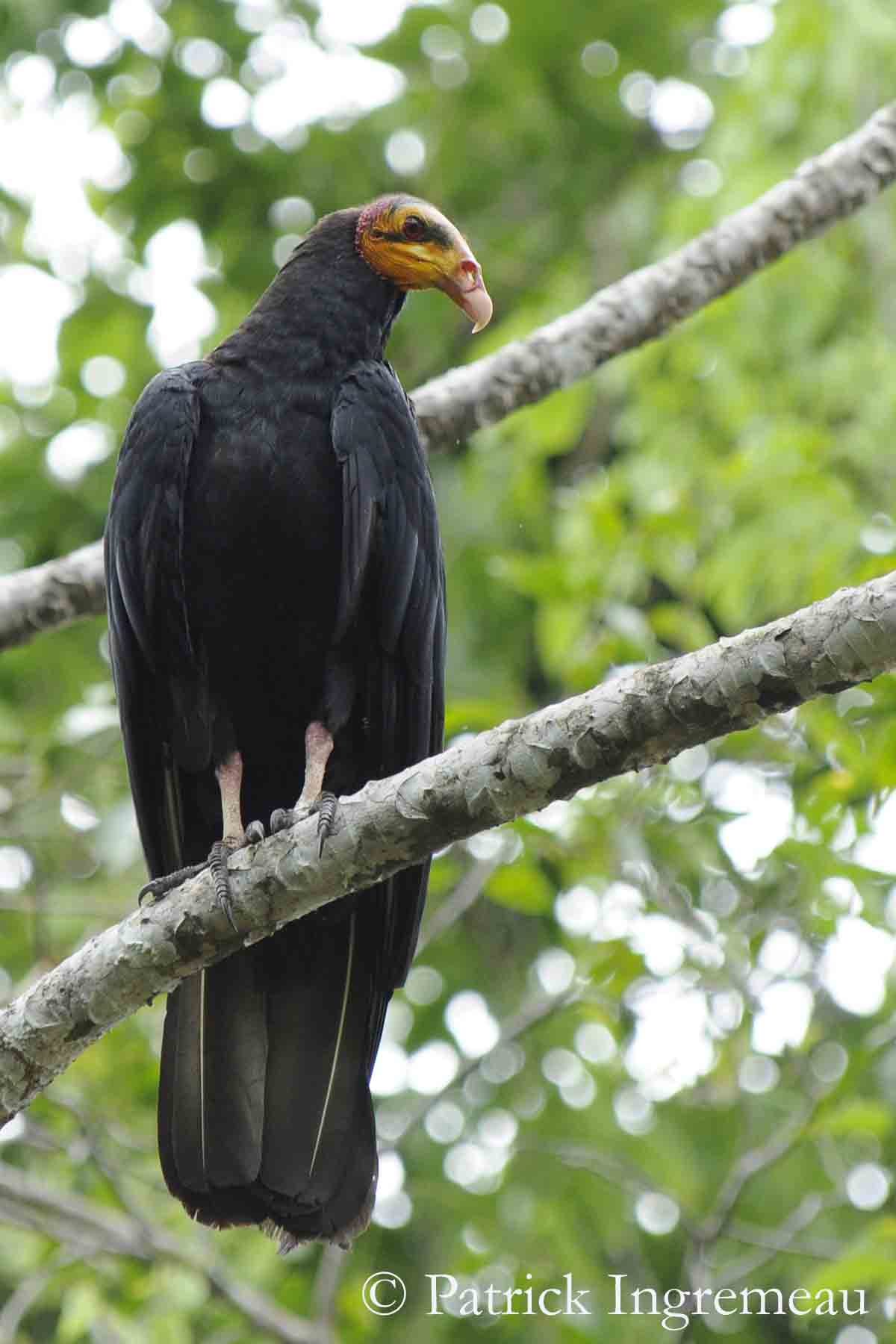Post by OldGreenVulture on Aug 4, 2019 9:48:02 GMT
Greater Yellow-headed Vulture
Cathartes melambrotus
Accipitriforme Order – Cathartidae Family
BIOMETRICS:
Length: 74-81 cm; Wingspan: 165-178 cm; Wingspan: 1650 g

DESCRIPTION:
The Greater Yellow-headed Vulture belongs to the New World Vulture family – Cathartidae, Ciconiiforme Order. It is also called “Forest Vulture”.
It is very similar to Lesser Yellow-headed Vulture (Cathartes burrovianus).
Adult male has black plumage overall, but we can see a pale green or purple iridescence on back and coverts.
Tail and wings are longer than in Lesser Yellow-headed Vulture.
On the underwings, the flight feathers appear paler in flight, forming a conspicuous contrast visible in flight.
On the head, the bare skin of the face is yellow, including cere, lores, forehead, fore crown, chin and cheeks to ear-coverts, as a mask.
This yellow skin may turn orange on neck and cheeks, and blue on crown.
The bill is pale pinkish-white. Eyes are reddish. Legs and feet are pinkish-red.
Both sexes are similar.
The young reaches its sexual maturity at about 5 to 6 years of age.
VOICE:
The Greater Yellow-headed Vulture, as other Cathartidae, only produces a variety of hissing or rattling sounds, and usually, it is almost silent.
These birds lack the syrinx and the associated muscles, necessary for producing calls or songs.
HABITAT:
The Greater Yellow-headed Vulture lives in undisturbed tropical forests, in heavily forested areas where it can shelter. It is rarely seen in open habitats, only wandering over grasslands, but seldom far from the forest.
RANGE:
The Greater Yellow-headed Vulture is found in some parts of the tropical South America, mainly in the Amazon Basin, including parts of the close countries, up to 1000 metres of elevation, rarely higher, but often up to 700 metres.
BEHAVIOUR:
The Greater Yellow-headed Vulture is a scavenger. This bird has a keen sense of smell, allowing finding carcasses, even of small animals. But it can also feed at large carcasses with other species.
It feeds slower than condors and large vultures, which mean it plays an important role by cleaning up all the remaining of meat, and by picking over the carcass until the little remains.
Cathartidae have the best smell of all vultures, and usually, they arrive at carcasses before the other species. They are quiet, and rarely engage aggressive behaviour, feeding close to each other, and even close to other vultures’ species.
The Greater Yellow-headed Vulture roosts on high exposed branches in dead trees. This vulture is mainly solitary or in pairs, rarely in groups, except at the carcasses.

FLIGHT:
The Greater Yellow-headed Vulture performs heavy but steady flight. The wings are held relatively flat, or just above horizontal. It soars, using the thermals, circling high in the air without flapping, thanks to the large wings.
It flies lower than other species, close to the ground. When flying in wooded areas, it flies at canopy-level, taking advantage of the small patches of rising air between the large trees emerging above the canopy.
REPRODUCTION:
The nesting behaviour of this species is poorly known. Any nest-site has ever been found for the Greater Yellow-headed Vulture.
Usually, the New World Vultures are monogamous. They may use caves or crevices in rocky cliffs, and they reuse the same nest year after year. They are solitary nesters.
The clutch includes 1 or 2 eggs, maybe more. The incubation lasts between 32 to 40 days. The chicks are covered with down. They are fed by regurgitated food, which is unusual in raptors.
During the first days, the chicks take the partially digested food direct from the bill of adults. Later, the young feed from regurgitated food on the ground.
They remain at nest several weeks and both parents care for them.

DIET:
The Greater Yellow-headed Vulture feeds mainly on carrion and insects. Carcasses are detected thanks to the keen sense of smell of this species, which is often the first arrived at feeding areas.
PROTECTION/THREATS/ STATUS:
The Greater Yellow-headed Vulture is fairly abundant in rainforest, but these raptors are threatened by clearing of forests and habitat destruction, and by the extension of human exploitation of the remaining forest areas.
The hunting of monkeys and other terrestrial mammals has an important impact on scavengers, by removing their main food sources, because the density of Cathartidae populations is closely related with the forest mammal’s density.
However, this species is relatively common in suitable habitat such as undisturbed forest.
Fr: Grand urubu
All : Großer Gelbkopfgeier
Esp : Aura Selvática
Ital : Avvoltoio testagialla maggiore
Nd : Grote Geelkopgier
Russe : Большая желтоголовая катарта
Photos de Patrick Ingremeau
Son site: TAMANDUA
Texte de Nicole Bouglouan
Sources :
HANDBOOK OF THE BIRDS OF THE WORLD Vol 2 by Josep del Hoyo-Andrew Elliot-Jordi Sargatal - Lynx Edicions - ISBN: 8487334156
A GUIDE TO THE BIRDS OF COLOMBIA by Steven L. Hilty and William L. Brown
Princeton University Press – ISBN 069108372X
L’ENCYCLOPEDIE MONDIALE DES OISEAUX - Dr Christopher M. Perrins - BORDAS - ISBN: 2040185607
www.oiseaux-birds.com/card-greater-yellow-headed-vulture.html
Cathartes melambrotus
Accipitriforme Order – Cathartidae Family
BIOMETRICS:
Length: 74-81 cm; Wingspan: 165-178 cm; Wingspan: 1650 g
DESCRIPTION:
The Greater Yellow-headed Vulture belongs to the New World Vulture family – Cathartidae, Ciconiiforme Order. It is also called “Forest Vulture”.
It is very similar to Lesser Yellow-headed Vulture (Cathartes burrovianus).
Adult male has black plumage overall, but we can see a pale green or purple iridescence on back and coverts.
Tail and wings are longer than in Lesser Yellow-headed Vulture.
On the underwings, the flight feathers appear paler in flight, forming a conspicuous contrast visible in flight.
On the head, the bare skin of the face is yellow, including cere, lores, forehead, fore crown, chin and cheeks to ear-coverts, as a mask.
This yellow skin may turn orange on neck and cheeks, and blue on crown.
The bill is pale pinkish-white. Eyes are reddish. Legs and feet are pinkish-red.
Both sexes are similar.
The young reaches its sexual maturity at about 5 to 6 years of age.
VOICE:
The Greater Yellow-headed Vulture, as other Cathartidae, only produces a variety of hissing or rattling sounds, and usually, it is almost silent.
These birds lack the syrinx and the associated muscles, necessary for producing calls or songs.
HABITAT:
The Greater Yellow-headed Vulture lives in undisturbed tropical forests, in heavily forested areas where it can shelter. It is rarely seen in open habitats, only wandering over grasslands, but seldom far from the forest.
RANGE:
The Greater Yellow-headed Vulture is found in some parts of the tropical South America, mainly in the Amazon Basin, including parts of the close countries, up to 1000 metres of elevation, rarely higher, but often up to 700 metres.
BEHAVIOUR:
The Greater Yellow-headed Vulture is a scavenger. This bird has a keen sense of smell, allowing finding carcasses, even of small animals. But it can also feed at large carcasses with other species.
It feeds slower than condors and large vultures, which mean it plays an important role by cleaning up all the remaining of meat, and by picking over the carcass until the little remains.
Cathartidae have the best smell of all vultures, and usually, they arrive at carcasses before the other species. They are quiet, and rarely engage aggressive behaviour, feeding close to each other, and even close to other vultures’ species.
The Greater Yellow-headed Vulture roosts on high exposed branches in dead trees. This vulture is mainly solitary or in pairs, rarely in groups, except at the carcasses.
FLIGHT:
The Greater Yellow-headed Vulture performs heavy but steady flight. The wings are held relatively flat, or just above horizontal. It soars, using the thermals, circling high in the air without flapping, thanks to the large wings.
It flies lower than other species, close to the ground. When flying in wooded areas, it flies at canopy-level, taking advantage of the small patches of rising air between the large trees emerging above the canopy.
REPRODUCTION:
The nesting behaviour of this species is poorly known. Any nest-site has ever been found for the Greater Yellow-headed Vulture.
Usually, the New World Vultures are monogamous. They may use caves or crevices in rocky cliffs, and they reuse the same nest year after year. They are solitary nesters.
The clutch includes 1 or 2 eggs, maybe more. The incubation lasts between 32 to 40 days. The chicks are covered with down. They are fed by regurgitated food, which is unusual in raptors.
During the first days, the chicks take the partially digested food direct from the bill of adults. Later, the young feed from regurgitated food on the ground.
They remain at nest several weeks and both parents care for them.
DIET:
The Greater Yellow-headed Vulture feeds mainly on carrion and insects. Carcasses are detected thanks to the keen sense of smell of this species, which is often the first arrived at feeding areas.
PROTECTION/THREATS/ STATUS:
The Greater Yellow-headed Vulture is fairly abundant in rainforest, but these raptors are threatened by clearing of forests and habitat destruction, and by the extension of human exploitation of the remaining forest areas.
The hunting of monkeys and other terrestrial mammals has an important impact on scavengers, by removing their main food sources, because the density of Cathartidae populations is closely related with the forest mammal’s density.
However, this species is relatively common in suitable habitat such as undisturbed forest.
Fr: Grand urubu
All : Großer Gelbkopfgeier
Esp : Aura Selvática
Ital : Avvoltoio testagialla maggiore
Nd : Grote Geelkopgier
Russe : Большая желтоголовая катарта
Photos de Patrick Ingremeau
Son site: TAMANDUA
Texte de Nicole Bouglouan
Sources :
HANDBOOK OF THE BIRDS OF THE WORLD Vol 2 by Josep del Hoyo-Andrew Elliot-Jordi Sargatal - Lynx Edicions - ISBN: 8487334156
A GUIDE TO THE BIRDS OF COLOMBIA by Steven L. Hilty and William L. Brown
Princeton University Press – ISBN 069108372X
L’ENCYCLOPEDIE MONDIALE DES OISEAUX - Dr Christopher M. Perrins - BORDAS - ISBN: 2040185607
www.oiseaux-birds.com/card-greater-yellow-headed-vulture.html

